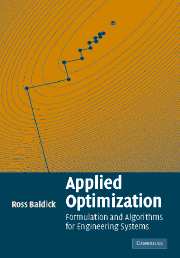Book contents
- Frontmatter
- Contents
- List of illustrations
- Preface
- 1 Introduction
- 2 Problems, algorithms, and solutions
- 3 Transformation of problems
- Part I Linear simultaneous equations
- 4 Case studies
- 5 Algorithms
- Part II Non-linear simultaneous equations
- Part III Unconstrained optimization
- Part IV Equality-constrained optimization
- Part V Inequality-constrained optimization
- References
- Index
4 - Case studies
Published online by Cambridge University Press: 03 December 2009
- Frontmatter
- Contents
- List of illustrations
- Preface
- 1 Introduction
- 2 Problems, algorithms, and solutions
- 3 Transformation of problems
- Part I Linear simultaneous equations
- 4 Case studies
- 5 Algorithms
- Part II Non-linear simultaneous equations
- Part III Unconstrained optimization
- Part IV Equality-constrained optimization
- Part V Inequality-constrained optimization
- References
- Index
Summary
In this chapter, we will develop two case studies of problems that involve the solution of linear simultaneous equations:
the solution of Kirchhoff's laws in a simple electrical circuit (Section 4.1), and
the search for a set of inputs to a “discrete-time linear system” that will bring the system to a desired state (Section 4.2).
The first case study will be developed in some detail, while the second will be much more briefly described. As we proceed, we will introduce notation to help us express ideas concisely and precisely. We will try to describe the choices that are made in formulating a model. You may already be very familiar with these models; however, the reasoning we present here may help you to pose and answer questions that arise in formulating your own models. We emphasize that the formulation of a new problem may involve many stages and refinements and that our presentation hides some of this process.
Analysis of a direct current linear circuit
Motivation
In designing a large integrated circuit to be fabricated or even a large circuit consisting of discrete components, it is very important to be able to calculate the behavior of the circuit without going to the expense of actually building a prototype. Furthermore, because of manufacturing tolerances, manufactured component values may differ from nominal. The values may also drift over the lifetime of the circuit. Both manufacturing tolerances and drift of component values can be interpreted as changes in the values of components from their nominal values in the base-case circuit.
- Type
- Chapter
- Information
- Applied OptimizationFormulation and Algorithms for Engineering Systems, pp. 161 - 185Publisher: Cambridge University PressPrint publication year: 2006

